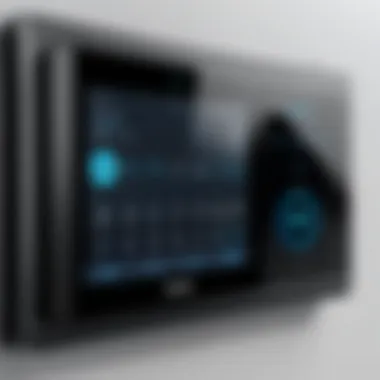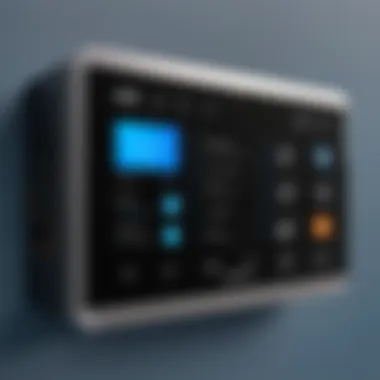Choosing the Best Intercom System for Your Home


Intro
Selecting an intercom system for your home can be a complex task. With so many options available, it is crucial to understand the key aspects that differentiate one system from another. This overview aims to encapsulate the essential elements of intercom systems, focusing on their functionalities, target audience, and key features. A precise comprehension of these elements can guide potential buyers through their decision-making process, ensuring that their final choice aligns with their specific needs.
Overview of the Product
Purpose and Benefits
An intercom system enables communication within various areas of a home. Its primary purpose is to facilitate easy communication, whether it's between family members in different rooms or between the front door and other parts of the home. Additionally, intercom systems can enhance home security, allowing users to verify who is at the door without having to physically approach it. They can serve as monitoring tools, which provide a sense of safety, especially for larger homes.
Target Audience
The target audience for intercom systems encompasses a diverse group, including homeowners looking to enhance their property's communication capabilities, security-conscious individuals, and families aiming for convenience. Tech enthusiasts may also find integrating intercom systems into their smart home setups appealing. Overall, these systems cater to those who value efficient communication and security in their living environment.
Key Features
The core features of intercom systems can vary widely, but essential ones include:
- Audio and/or Video Communication: Some intercoms offer visual connectivity, allowing users to see who is communicating.
- Wireless Connectivity: Many modern systems operate wirelessly, eliminating the need for complex wiring installations.
- Multiple Station Capability: Users can communicate from various points within the home, enhancing user experience.
- Integration with Smart Home Devices: Compatibility with other smart devices can add significant value, enabling centralized control of home systems.
"Choosing the right intercom system can directly impact your home's safety and convenience. Select one that meets your specific needs and lifestyle."
Understanding the features and target demographics involved in intercom systems is integral to selecting the optimal model for home use. This consideration not only aids in making a more informed choice but ensures that the chosen system enhances daily functions within the household. The subsequent sections will delve deeper into specifications and comparisons of available products to aid potential buyers in making educated decisions.
Understanding Intercom Systems
Intercom systems serve as a pivotal communication tool within a home, enhancing connectivity between various areas. Such systems can result in increased efficiency and security, especially in larger homes or buildings. Understanding the diverse functionalities and types of intercom systems is essential for making an informed decision during the selection process.
Definition and Purpose
An intercom system is a two-way communication device that allows users to connect and talk with one another over a distance. Primarily used in homes, these systems can facilitate communication between rooms, at entrances, or even between different buildings in larger properties. The purpose of an intercom system extends beyond mere communication; it can also enhance security, enabling homeowners to verify who is at the door before granting access. Moreover, it serves to improve interactions within the home, whether calling family members for dinner or coordinating activities in different rooms.
Types of Intercom Systems
Understanding the different types of intercom systems available is crucial in identifying the most suitable option for a specific home environment. They can mainly be categorized into the following four types:
Wired Intercom Systems
Wired intercom systems are traditional setups that use physical wiring to connect units within a home. This type is characterized by its reliability and is often less susceptible to interference compared to wireless options. A notable benefit of wired systems is their consistent audio quality, making them a preferred choice for homeowners seeking efficient communication. However, installation can be labor-intensive, requiring proper planning and sometimes professional assistance.
Wireless Intercom Systems
Wireless intercom systems have become increasingly popular due to their convenience and ease of installation. These systems utilize radio frequencies or Wi-Fi to transmit audio and sometimes video signals. One significant advantage is that they do not require extensive wiring, making them flexible and suitable for homes where retrofitting is difficult. However, the audio quality may vary, and users might experience interference from other devices, which can detract from the overall performance.
Video Intercom Systems


Video intercom systems add a visual component to communication, allowing users to see who they are talking to or who is at the door. This type enhances security and provides peace of mind, especially for households that receive frequent visitors. A key feature of video intercom systems is their ability to connect to smartphones or tablets, enabling remote monitoring. Nevertheless, they are often more expensive and require a stable power source and internet connection to function optimally.
Smart Intercom Systems
Smart intercom systems represent the latest advancements in the field, integrating with other smart home technologies. These systems often feature advanced functionalities, including mobile alerts and integration with voice assistants. A key characteristic of smart intercoms is their ability to be controlled via mobile apps, providing users with convenience and flexibility. However, they can be more complex to set up and may present security concerns if not properly configured, as they rely on internet connectivity.
Key Features to Consider
When selecting an intercom system, understanding the key features is essential. Different systems serve varying needs and environments. Identifying these features helps users effectively use the technology, ensuring they choose a system that best fits their personal scenarios. Each feature contributes to functionality, ease of use, and overall satisfaction with the product.
Audio Quality
Audio quality is fundamental in intercom systems. Clear sound ensures communication is effective, allowing users to understand messages without needing repetitions. High-definition audio can reduce background noise and enhance clarity. Look for systems that specify noise-cancellation features or high-quality speakers. Investing in a model with superior audio quality makes a notable difference in user experience, especially in larger homes where sound may distort.
Video Capability
Video capability could be a game-changer for home intercom systems. It provides visual confirmation of who is at the door or within the home, enhancing security. Many systems now integrate high-resolution cameras with night vision and motion detection. Look for models that allow for real-time video feeds and record functionality. This helps in keeping a record of visitors. Quality video output can further facilitate engagement, especially for families that want to check in visually.
Range and Connectivity
Range and connectivity is vital in ensuring the intercom system operates without disruptions. Wireless systems, for instance, must maintain a stable connection within the home. It is important to know the maximum distance the system can cover. Lookout for systems that work well in larger homes or those with multiple floors. If wired, proper installation should adhere to any standards. Stability in connectivity also influences real-time communication.
Integration with Smart Home Devices
Integration with smart home devices offers added convenience and functionality. Many intercom systems now work with platforms like Google Home or Amazon Alexa. Such connections enable voice commands, allowing users to manage intercom operations hands-free. Users should assess compatibility with existing smart devices. This feature not only streamlines the user experience but also enhances overall home security and automation capabilities.
User Interface and Usability
A user-friendly interface is crucial for any intercom system. Complex systems may lead to frustration rather than ease of use. The layout of controls and the quality of displays contribute to overall usability. Touch screens and voice-activated controls often improve user experience. It's also wise to check if the system provides mobile app support, facilitating communication on-the-go. An intuitive design encourages regular use, maximizing the intercom's potential.
User satisfaction is often closely linked to how effortlessly one can utilize technology. Ensuring a positive user experience can enhance overall engagement.
Comparative Analysis of Leading Intercom Systems
The selection of an intercom system can significantly impact a homeowner's day-to-day experience. A comparative analysis of leading intercom systems offers insight into their features, usability, and reliability. It allows users to weigh their options based on specific needs and preferences.
Understanding the key differences between various systems lays the groundwork for an informed decision. Benefits of this comparison include identifying the most suitable technology for your housing layout, as well as discovering models that fit both budgetary constraints and desired functionalities.
Wired Options vs.
Wireless Options
When deciding between wired and wireless intercom systems, one must consider several factors. Wired systems typically offer more stability in terms of connection, while wireless systems provide greater flexibility and simpler installation.
- Wired Intercom Systems:
- Wireless Intercom Systems:


- Higher installation complexity but very reliable.
- Generally offers better sound quality and less interference.
- Easier to set up, requiring no drilling or extensive wiring.
- Can suffer from signal interference, especially in houses with thick walls.
Each option has unique advantages and disadvantages, making it crucial to consider your own circumstances before choosing.
Top Wired Intercom Systems
Brand A Overview
Brand A stands out due to its robust build and exceptional sound fidelity. It is widely recognized for offering high-quality audio, making it an attractive choice for those who prioritize clear communication. One key characteristic of Brand A is its durable components, ensuring longevity even with heavy usage. However, its complexity in installation may deter some users.
Brand B Overview
Brand B focuses on modern design and user-friendly interfaces. Its systems typically come with multi-channel options, catering to larger homes. A major selling point for Brand B is its intuitive touchscreen functionality that enhances usability. Still, the price point can be higher compared to competitors, which some may find not worth the investment.
Brand Overview
Brand C excels in affordability without sacrificing quality. It is a go-to choice for budget-conscious households. The standout feature is its versatile connectivity options, allowing integration with various home devices. However, users have reported occasional sound clarity issues, which can hinder performance during critical moments.
Top Wireless Intercom Systems
Brand Overview
Brand D reflects a blend of innovation and convenience. Its wireless design simplifies installation, appealing to those who prefer an easy setup. A highlight of Brand D is its mobile app integration, enabling users to communicate from their smartphones. Nonetheless, the range can be limited by environmental factors, affecting performance.
Brand E Overview
Brand E emphasizes security along with standard intercom functions. With added video monitoring features, it provides peace of mind for homeowners. The key characteristic here is the advanced encryption technology, ensuring secure communications. However, initial setup may be complex for some users without technical skills.
Brand F Overview
Brand F is known for its reliability and extensive range. Users appreciate its ability to maintain connections even at considerable distances from the base unit. One unique feature is its intercom-to-intercom calling, allowing seamless communication throughout larger homes. A potential downside includes battery life issues, which some users have experienced.
Top Video Intercom Systems
Brand G Overview
Brand G is designed for high-resolution video feeds and crisp audio, making it popular among security-conscious customers. Key characteristics include sophisticated motion detection and night vision. It is considered a premium choice but comes with a higher price tag that may not fit all budgets.
Brand H Overview
Brand H caters to family-oriented households by including features like two-way communication and multiple device connectivity. Its user-friendly interface and clear design appeal to a broad audience. However, some users have mentioned occasional lag in video feed, which may affect usability.
Brand Overview


Brand I combines cutting-edge technology with affordability. It is favored for its multifunctionality, allowing users to switch between audio and video seamlessly. A noteworthy drawback, however, has been noted in its software updates, which can be less frequent than expected, leading to user frustration.
Installation and Maintenance Considerations
Understanding installation and maintenance for an intercom system is crucial. These aspects ensure that the system operates efficiently and meets user needs over time. Proper installation can affect the system's performance, while regular maintenance extends its lifespan. Both factors combined contribute to a seamless user experience.
Installation Process Overview
The installation process of intercom systems varies depending on the type. For wired systems, it often requires more extensive setup involving drilling and running cables. This includes identifying appropriate locations for units, and ensuring power sources are available. In contrast, wireless systems might demand less physical labor but still need thoughtful placement to maintain strong signal connectivity.
The installation generally involves these steps:
- Evaluate Requirements: Assess the number of units and their positions in the house. Understand where you want to install the base station and the intercom units.
- Select the Right System: Based on the evaluations, choose a wired or wireless intercom.
- Gather Tools and Equipment: For wired systems, tools like drills, cables, and possibly a ladder will be required.
- Follow the Manual: Refer to the provided manual; it typically outlines the steps clearly.
- Testing: After installation, thoroughly test the system to ensure every unit can communicate effectively.
Common Installation Challenges
Despite the clarity of the installation manuals, some challenges may arise during the process. These can include:
- Signal Interference: Wireless intercoms can suffer from interference caused by walls, appliances, or even other wireless devices.
- Accessibility: Reaching higher locations for installation, especially in larger homes, can be a hassle.
- Wiring Issues: For wired systems, ensuring that all wires are hidden and correctly connected can sometimes be more complicated than anticipated.
- Customization Difficulties: Some systems may not allow for easy customization after installation, leading to frustrations.
Maintenance Tips for Longevity
Like any tech system, intercoms require maintenance to ensure long-lasting performance. Here are several key tips:
- Regular Updates: For smart intercoms, keep firmware updated. This can resolve bugs and improve security.
- Clean Units: Dust and dirt can hinder microphone and speaker performance. Regularly wipe down the units.
- Check Connections: Ensure all connections, especially in wired systems, remain secure. Loose connections may lead to poor audio quality.
- Test Functionality: Periodically test the system to spot issues early. This includes checking audio and video quality.
Following these maintenance tips can significantly enhance the life and efficiency of your intercom system, ensuring that it serves its purpose well.
Investing time in proper installation and ongoing maintenance is key for maximizing the benefits of your intercom system. Without this, users may find their systems underperforming.
Closure and Recommendations
The conclusion and recommendations section of this article serves as a crucial pivot point. It synthesizes the insights derived from previous sections. By emphasizing the importance of selecting the right intercom system based on individual needs, this part aims to guide the reader thoughtfully.
A well-chosen intercom system can significantly enhance security and communication within a home. More than just a convenience, it addresses various user needs, allowing for tailored solutions. Consequently, this section provides not only a summary of key points but also actionable recommendations that readers can implement.
Personalization Based on User Needs
Personalizing your choice of an intercom system is essential. Each household has unique needs that must be carefully considered. For instance, a family with children might prioritize safety features. Video intercom systems could be crucial here, providing visual access to who is at the door. On the other hand, tech-savvy users may prefer smart intercoms that integrate seamlessly with existing smart home devices.
Additionally, aspects such as the size of the home and layout matter. In large homes, systems with extensive connectivity range are beneficial. Meanwhile, smaller apartments may only require basic intercom features. Factors like audio quality and user interface cannot be overlooked either. A system laid out for easy use will save time and effort in daily operations.
In summary, understanding family dynamics, security needs, and technical capabilities can shape a suitable intercom choice. The process of identifying an optimal system lies in recognizing these elements and matching them with available technology.
Final Thoughts on Choosing an Intercom System
In closing, selecting an intercom system is not merely a matter of brand reputation or popularity. It requires thoughtful investigation into the specific features that align with one's requirements. Each intercom type offers distinct benefits and possible drawbacks. Consumers should evaluate their options against their priorities, whether it be advanced functionality, user-friendly interfaces, or integration capacities.
Compatibility with current technology investments should also be addressed. This can streamline operations and enhance the overall user experience.
Investing in the right intercom system can yield long-term benefits that support both security and straightforward communication in the home.
By keeping the aforementioned factors at the forefront during the selection process, readers can make educated decisions that cater to their unique domestic environments. Choosing the right intercom system is a blend of art and science; personal biases must align with practical needs and preferences.



